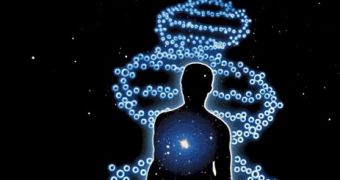Life is subdued to a continuous development. With each new generation, advantages increase, while disadvantages are removed, and new possibilities are exploited. An ancestral species forms several new species and can disappear, or to survive in its original form adapting to its own niche in the system.
The result is a complicated network of relationships connecting living organisms on Earth to ancient disappeared ancestors. Remains of these organisms are kept as fossils. Fossils are encountered in sedimentary rocks whose age can be determined, and a history of life could be made. In the Life Tree, some branches died (like dinosaurs), others are in bloom (like mammals).
Earth is believed to be 4.5 billion years old, but the oldest rocks with visible fossils are just 590 million years old, from the beginning of the Cambrian. Cambrian fossils are made of a large array of life forms, like worms and mollusks, obviously evolved from more primitive forms.
Organisms from Precambrian are less likely to have fossilized because they lacked a hard shell or skeleton; soft tissue totally decomposes after death, before the sediments manage to petrify them, turning them into fossils.
Still, in 1950, a 2 billion years old rock on the shore of Lake Superior, called flint silica, was found to contain remains of bacteria and monocellular algae. White rings on the rock proved to be eroded remains of their colonies, spherical rocky formations called stromatolites. Fossil bacteria and algae were embedded in the silica, like fossil insects in amber. This discovery made scientists re-examine old rocks. The oldest life forms were encountered in western Australia: 3.5 billion years old.
A bacterium is a simple cell that absorbs simple nutrients transformed into complex organic chemicals that form its body and deliver energy. All is controlled by DNA, a chemical that encodes proteins. The proteins called enzymes control all the functioning of the cell. DNA can also auto-reproduce. Each DNA is like a stair-resembling double helix. The stairs are made by bonding bridges. The bonds can break up and each side of the DNA can remake the missing part, resulting two double helixes.
This trick allows the cell to grow and reproduce. In multicellular organisms, cells cooperate, being part of a larger organism. All is controlled by DNA, whose structure differs from one organism to another. The more sophisticated an organism is, the more complex its DNA is. Still, even the simple DNA of a bacterium is made of thousands of nucleotide bases (made of sugars, phosphates and the proper base).
Proteins represent polymers made of various combinations of 20 amino-acids. The pattern is specific and proteins vary from 100 amino-acids to thousands of amino-acids.
As bacteria are the simplest life forms, they must have formed from lifeless structures, which synthesized essential components of life before using them.
In 1920, Oparin and Haldane emitted the hypothesis that when life emerged, about 3.8 million years ago, the atmosphere was almost completely devoid of oxygen, but rich in ammonia, water, carbon monoxide, methane, hydrogen and many other chemicals. The surface of the Earth could have been covered by hot water, continuously boiling due to the incandescent rocks found beneath the thin crust of the oceans.
This combination of gases and water could have made a "soup" rich in the chemicals required for life synthesis. The key reactions could have been triggered by volcanic activity, intense UV radiation penetrating through the thin atmosphere or electric energy coming from lightnings. This was tested in 1953 by Stanley Miller. He mixed those chemicals under those conditions in glass tubes and decanters.
When Miller heated the mix from the lower decanter, the gas passed through a spark chamber and then condensed, draining back to the lower decanter. For a week, the mix was continuously heated, treated with sparks and condensed, then analyzed. The results were satisfactory: the sparked mix contained three aminoacids, the "bricks" for protein synthesis. Similar experiments got even more aminoacids and even nucleotide bases, the "bricks" for DNA making. Some say proteins and complex sugars could have formed through evaporation or freezing.
In billions of years, all the proteins (and many chemicals) could be synthesized. Even DNA, with its bases, could be made. Once emerged by chance, DNA could auto-replicate, produce its own proteins and other complex chemicals and turn into a fully functioning life form able to auto-reproduce, just like a bacterium.
This could have happened, but the mathematical probability that a complex chemical, like a protein or DNA, to be generated by the aleatory association in a primitive ocean is infinitely small. Scientists are looking for a mechanism that determines the amino-acids to associate and form proteins without the assembly instructions given by DNA. Such a mechanism could explain the DNA origins and that of life itself.

 14 DAY TRIAL //
14 DAY TRIAL //